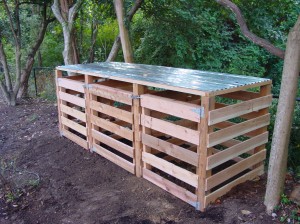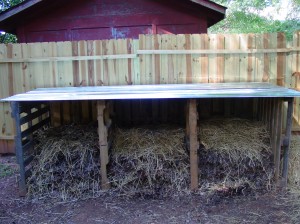Better Than Plastic : High Capacity Compost Systems
 Tuesday, November 8, 2011 at 7:21AM
Tuesday, November 8, 2011 at 7:21AM  Raking up leaves and putting them in clear plastic bags to send to the dump makes about as much sense as washing your car in the rain. Organic matter like leaves, grass clippings, coffee grounds, and vegetable scraps can be turned into humus ; an amazing material that creates rich, living soil and healthy plants.
Raking up leaves and putting them in clear plastic bags to send to the dump makes about as much sense as washing your car in the rain. Organic matter like leaves, grass clippings, coffee grounds, and vegetable scraps can be turned into humus ; an amazing material that creates rich, living soil and healthy plants.
At Microfarm, we endorse the proven, three bin design used by organizations worldwide to recycle large amounts of organic material. Research has shown that the ideal size of a compost pile is about four cubic feet- much larger than the average store bought, plastic compost bin . The mass of a four cubic foot pile facilitates rapid decomposition, but isn’t too big to turn with a simple handheld garden tool like a spading fork.
The design is simple, consisting of three , or sometimes just two 4’x4’x4’ stalls, with a hinged roof to control the amount of water in the piles.
For a long, productive life, use a durable lumber like Western Red Cedar, and galvanized fasteners and roofing material. Just like in a raised garden bed application, you should steer clear from pressure treated lumber, as the chemicals could ultimately wind up in your food.
Shipping pallets are also commonly used to create this three bin compost system, and are easier on the wallet than cedar. Pallets are typically made from untreated hardwood, so you can expect 2-3 years before the wood decays.
So How Do I Make Compost?
Composting isn’t complicated, and really comes down to…
What should I put in my compost pile?
A combination of nitrogen based, ‘green’ organic material and carbon based, ‘brown’ organic material. To create rapid decomposition in your pile, you’ll need at least one part nitrogen based material for every 25 parts carbon based material. Adding water and turning the pile regularly with a garden fork, introduces oxygen, and speeds up the decomposition process dramatically.
Nitrogen based green materials : coffee grounds, grass clippings, green weeds, manures, seaweed, stalks, stems and leaves from crops
Carbon based brown materials : cocoa hulls, hay dry leaves, peanut hulls, peat moss, sawdust, straw, old mulch
These additional ingredients also add phosphorous, potassium, and trace minerals to your compost pile:
Eggshells, melon rinds, wood ashes, banana skins, orange peels, stale bread, apple peels, potato skins, pea pods, and tea leaves.
What should I NOT put in my compost pile?
-weeds that have already gone to seed ( the seeds may survive)
-visibly diseased or insect infested material
-meat, grease or fat ; it attracts rodents and other pests
-waste from carnivorous animals like cats and dogs, which can transfer parasites to the compost pile
-grass clippings or weeds that have been treated with chemical fertilizers or weed killer
-manure or bedding from farms that use herbacides
-poison ivy, sumac, or oak
-pine needles or large branches ; they take a very long time to break down
Interested in owning a high capacity compost system? Give us a call at 704.568.8841, or write to info@microfarmgardens.com








Reader Comments